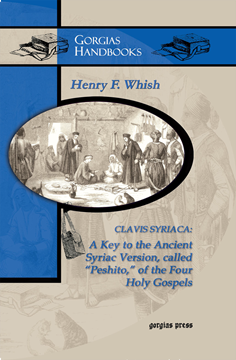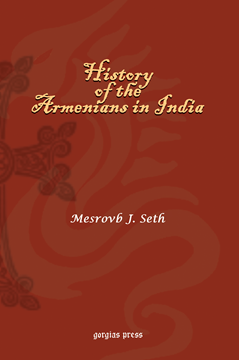Clavis Syriaca: A Key to the Ancient Syriac Version Called “Peshitto” of the Four Holy Gospels
By H. Whish
Series: Gorgias Handbooks 3
ISBN: 1-59333-177-0
Clavis Syriaca furnishes a complete analysis of the text of the Gospels of the Peshitta New Testament and is an excellent study tool for students who wish to study it. The Clavis begins with the Gospel of St. John, as its language is the simplest, and ends with that of St. Luke. It is an indispensable tool for any student of the New Testament or the Syriac language. Words are analyzed according to text placement, translation, grammar, and Greek, Hebrew and Aramaic cognates.
$230.00 (USD)
India and the Apostle Thomas
An inquiry with a critical analysis of the Acta Thomae
ISBN: 1-59333-180-0
Did St. Thomas visit India or is the story a legend? Medlycott provides the answer using archeological and patristic sources.
$170.00 (USD)
Lectures on the History of the Eastern Church
ISBN: 1-59333-052-9
Twelve lectures on the branches of the Eastern Church, with an introduction on the province, the methods and the advantages of the study of Church History, by Arthur Stanley, Canon of Canterbury and Regius Prof. of Church History at Oxford (d. 1858).
$131.00 (USD)
The Conversion of India
From Pantaenus to the Present Time (AD 193-1893)
By George Smith
ISBN: 1-59333-135-5
This book, based on six lectures by the author, gives the history of the conversion of India to Christianity from the earliest times until 1893. Smith’s work is useful for understanding the American missionary mentality of the nineteenth century.
$153.00 (USD)
Eighteen Centuries of the Orthodox Greek Church
ISBN: 1-59333-051-0
Using the Seven Ecumenical Councils as backbone, Hore provides the reader with an overview of the Greek Orthodox Church. Writing in an era when the Oxford Movement was reaching a wide array of Anglicans with the forgotten connections with orthodoxy, Hore presents a sympathetic view of Byzantine Christianity. Following the trials and difficulties of the early church after it received imperial approval, a sketch of the Greek Church, including the "separatist" Churches, emerges.
$204.00 (USD)
History of the Armenians in India
ISBN: 1-59333-049-9
The only history of its kind ever written, this book narrates the advent of the Armenian colony in India and its contribution to the East India Company. Seth describes in detail the Armenians’ commerce and power, as well as their literary and social activities.
$82.00 (USD)





